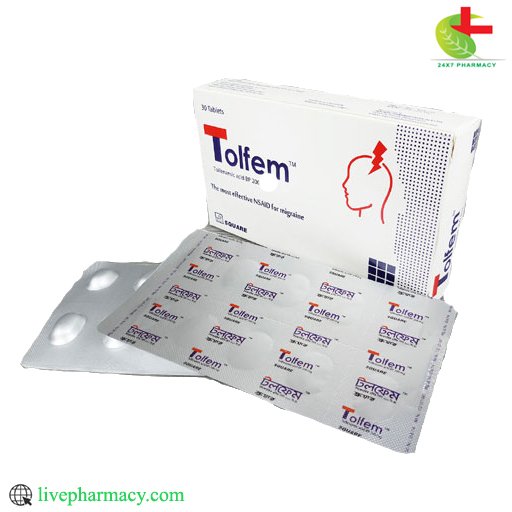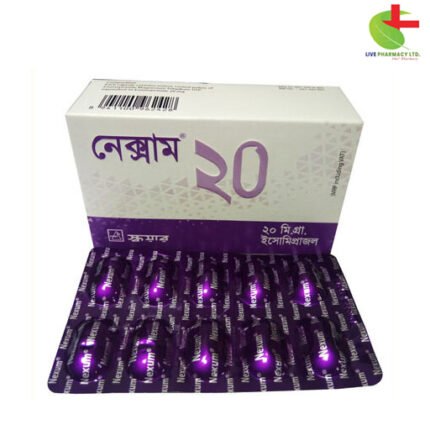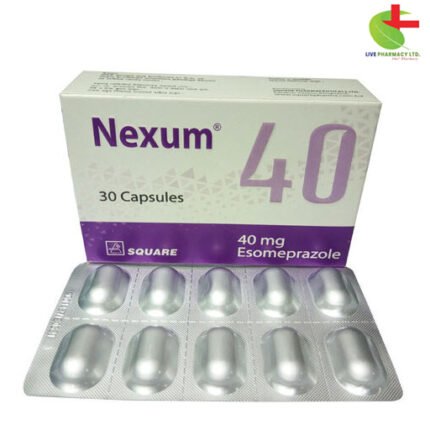Tolfem 200
100.00৳ Strip
- Tolfem offers relief for migraine headaches and post-operative pain
- Contains tolfenamic acid, a potent inhibitor of cyclooxygenase enzyme
- Swift absorption and effective dosage regimen
- Trusted solution for acute pain management
 Brand
Brand
|
Square Pharmaceuticals PLC |
|---|---|
 Generics
Generics
|
Tolfenamic acid |
Indications
Tolfem is utilized for the specific purpose of alleviating the discomfort associated with migraine headaches and is recommended as an analgesic for post-operative pain and fever.
Pharmacology
Belonging to the fenamate group, tolfenamic acid (N-(2-methyl-3-chlorophenyl) anthranilic acid) acts as a potent inhibitor of the cyclooxygenase enzyme. By doing so, it impedes the synthesis of crucial inflammatory mediators such as thromboxane (TX) B2 and prostaglandin (PG) E2. These prostaglandins are responsible for inducing swelling, pain, and inflammation in various conditions. Tolfenamic acid not only inhibits prostaglandin synthesis but also exhibits direct antagonistic action on their receptors.
Pharmacokinetic Properties
Tolfenamic acid is readily absorbed from the gastrointestinal tract. Peak plasma concentration is achieved within 60-90 minutes. Its bioavailability is approximately 85%. The medication is highly protein-bound (99%) and has a plasma half-life of 2 hours. Metabolism primarily occurs in the liver, with tolfenamic acid undergoing enterohepatic circulation. It is excreted mainly in urine (90%) and feces.
Dosage & Administration For adults
- Acute migraine attacks: 200 mg at the onset of symptoms, with the option to repeat once after 1-2 hours.
- Mild to moderate pain: 100-200 mg three times a day. Dose adjustments may be necessary for individuals with renal impairment. Severe renal impairment warrants avoidance of the medication. A pediatric dosage regimen has not been established.
Tolfenamic acid should be taken with food and accompanied by water during or immediately after meals.
Interactions
The absorption rate of Tolfem is enhanced when co-administered with metoclopramide and magnesium hydroxide but decreased with aluminum hydroxide. Concomitant use with anticoagulants and other NSAIDs increases the risk of bleeding. It diminishes the antihypertensive response to loop diuretics, beta-blockers, and ACE inhibitors. Co-administration also elevates the plasma concentration of lithium, methotrexate, and cardiac glycosides, and increases the risk of nephrotoxicity with ACE inhibitors, ciclosporin, tacrolimus, or diuretics.
Contraindications
Tolfem is contraindicated in cases of active gastrointestinal bleeding or ulceration, history of gastrointestinal bleeding related to previous NSAID therapy, history of gastrointestinal hemorrhage or perforation related to previous NSAID therapy, history of recurrent gastrointestinal ulceration, and severe heart failure.
Side Effects
Adverse effects of Tolfem may include rare occurrences of alveolitis, hepatic damage, pancreatitis, pulmonary eosinophilia, Stevens-Johnson syndrome, angioedema, blood disorders, depression, diarrhea, dizziness, drowsiness, dysuria, euphoria, gastrointestinal bleeding, gastrointestinal discomfort, hallucination, insomnia, malaise, nausea, hearing disturbances, rash, visual disturbances, vertigo, and elevated blood pressure. Symptoms of overdose may comprise headache, nausea, vomiting, gastrointestinal bleeding, drowsiness, dizziness, and occasionally convulsions. Acute renal failure and liver damage are possible in cases of significant poisoning.
Pregnancy & Lactation
The use of Tolfem is not recommended during pregnancy unless deemed essential by a healthcare provider. It should be avoided during the third trimester. NSAIDs may appear in breast milk at very low concentrations, and their use should be avoided, if possible, during breastfeeding.
Precautions & Warnings
Special precautions should be taken for patients with asthma, bronchospasm, bleeding disorders, cardiovascular diseases, peptic ulceration, hypertension, liver infection, cardiac or renal function impairment, and in the elderly. Increased water intake or dose reduction may be necessary to mitigate dysuria.
Overdose Effects
Overdose symptoms may include headache, nausea, vomiting, epigastric pain, gastrointestinal bleeding, diarrhea, excitation, coma, drowsiness, dizziness, tinnitus, fainting, and convulsions. Patients should be managed symptomatically as required.
Therapeutic Class
Tolfem belongs to the therapeutic class of drugs used for rheumatoid arthritis, non-steroidal anti-inflammatory drugs (NSAIDs), and other drugs for migraine.
Storage Conditions
The medication should be stored in a cool, dry place, away from light, and out of the reach of children.
Chemical Structure
Molecular Formula: C14H12ClNO2 Chemical Structure: Tolfenamic acid’s chemical structure.
Common Questions about Tolfem 200 mg Tablet
What is Tolfem 200 mg Tablet? Tolfem 200 mg Tablet is a potent inhibitor of the cyclooxygenase enzyme, thereby inhibiting the synthesis of crucial inflammatory mediators such as thromboxane (TX) B2 and prostaglandin (PG) E2.
What are the uses of Tolfem 200 mg Tablet? Tolfem 200 mg Tablet is utilized for the treatment of acute migraine attacks and mild to moderate pain.
Quick Tips
- Tolfem 200 mg Tablet should be taken with food or milk to prevent an upset stomach.
- Prolonged use of Tolfem 200 mg Tablet may lead to serious complications such as stomach bleeding and kidney problems.
- Tolfem 200 mg Tablet may increase the risk of blood clots, heart attack, or stroke.
- Inform your healthcare provider if you are pregnant, planning to conceive, or breastfeeding.
- Inform your healthcare provider if you have been diagnosed with kidney or liver problems in the past.













Reviews
There are no reviews yet.